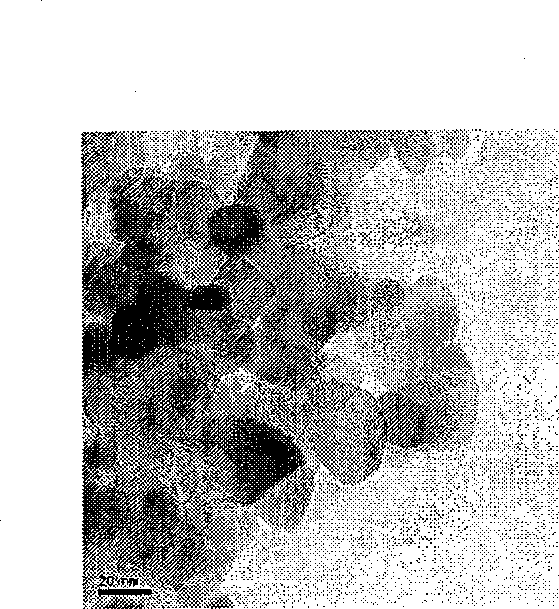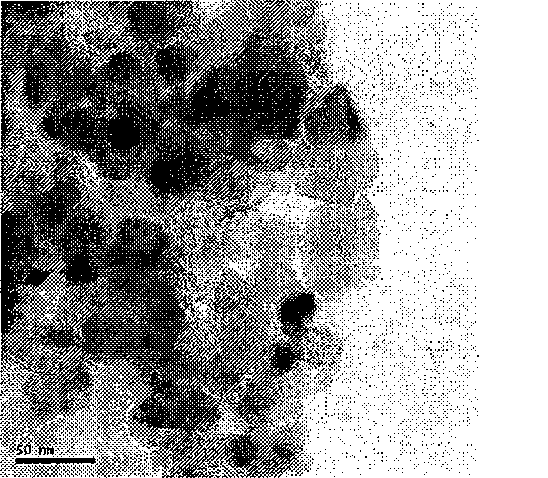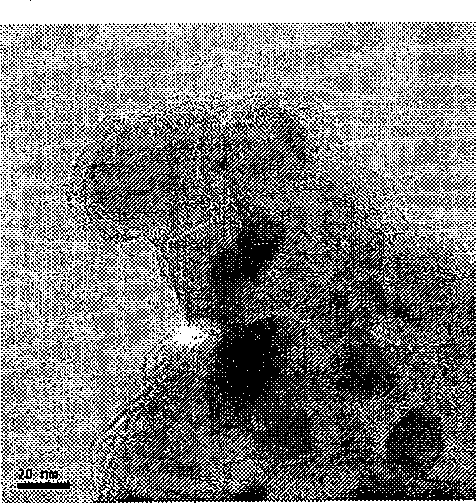Method for preparing interface optical catalyst
A photocatalyst and photocatalytic technology, applied in the direction of catalyst activation/preparation, chemical instruments and methods, physical/chemical process catalysts, etc., can solve the problems of zero photocatalytic activity and loss of application value
- Summary
- Abstract
- Description
- Claims
- Application Information
AI Technical Summary
Problems solved by technology
Method used
Image
Examples
Embodiment 1
[0045] Embodiment 1, see Figure 9 ,
[0046] (1) Firstly, the hollow photocatalytic particle SiO with a silica shell-hollow layer-titania nano-core structure is produced 2 @@TiO 2 , (see 200610154415.X for the accompanying drawings).
[0047] (a) Pretreatment of titania nanoparticles with TiO 2 To represent,
[0048] Add 100 mg of titanium dioxide nanoparticles into a NaOH solution with a concentration of 0.5 mol / L, and magnetically stir at a speed of 500 rpm for 7 hours, then wash with water three times and centrifuge until the pH is 7 for use.
[0049] (b) The process of wrapping carbon on the surface of nanoparticles, using C@TiO 2 To represent,
[0050] Add 100 mg of nanoparticles prepared in step (a) into polyvinyl alcohol resin (PVA) in an aqueous solution of carbon-containing organic matter soluble in water at a concentration of 0.7 mol / L. After thorough mixing, the mixed solution was introduced into a hydrothermal reaction kettle, and heat-treated at 150° C. fo...
Embodiment 2
[0064] Embodiment 2, see Figure 9 ,
[0065] (1) Firstly, the hollow photocatalytic particle SiO with a silica shell-hollow layer-titania nano-core structure is produced 2 @@TiO 2 , (see 200610154415.X for the accompanying drawings).
[0066] (a) Pretreatment of titania nanoparticles with TiO 2 To represent,
[0067] Add 500 mg of titanium dioxide nanoparticles into HCl solution with a concentration of 1.2 mol / L, and magnetically stir at 1000 rpm for 14 hours, then wash with water five times and centrifuge until the pH is 7 for use.
[0068] (b) The process of wrapping carbon on the surface of nanoparticles, using C@TiO 2 To represent,
[0069] Add 450 mg of nanoparticles prepared in step (a) into polyethylene glycol (PEG) in an aqueous solution of carbon-containing organic matter soluble in water at a concentration of 2.2 mol / L. After thorough mixing, the mixed solution was introduced into a hydrothermal reaction kettle, and heat-treated at 200° C. for 8 hours. After...
Embodiment 3
[0083] Embodiment 3, see Figure 9 ,
[0084] (1) Firstly, the hollow photocatalytic particle SiO with a silica shell-hollow layer-titania nano-core structure is produced 2 @@TiO 2 , (see 200610154415.X for the accompanying drawings).
[0085] (a) Pretreatment of titania nanoparticles with TiO 2 To represent,
[0086] Add 300 mg of titanium dioxide nanoparticles into NaOH solution with a concentration of 0.8 mol / L, and magnetically stir at 750 rpm for 10 hours, then wash with water four times and centrifuge until the pH is 7 for use.
[0087] (b) The process of wrapping carbon on the surface of nanoparticles, using C@TiO 2 To represent,
[0088] 275 mg of nanoparticles prepared in step (a) was added into an aqueous solution of carbon-containing organic matter soluble in water sucrose (Sucrose) with a concentration of 1.4 mol / L. After thorough mixing, the mixed solution was introduced into a hydrothermal reaction kettle, and heat-treated at 175° C. for 5 hours. After th...
PUM
| Property | Measurement | Unit |
|---|---|---|
| size | aaaaa | aaaaa |
Abstract
Description
Claims
Application Information
 Login to View More
Login to View More - R&D
- Intellectual Property
- Life Sciences
- Materials
- Tech Scout
- Unparalleled Data Quality
- Higher Quality Content
- 60% Fewer Hallucinations
Browse by: Latest US Patents, China's latest patents, Technical Efficacy Thesaurus, Application Domain, Technology Topic, Popular Technical Reports.
© 2025 PatSnap. All rights reserved.Legal|Privacy policy|Modern Slavery Act Transparency Statement|Sitemap|About US| Contact US: help@patsnap.com



